Young adults are flocking to art galleries and museums to satisfy their restless quest for distinctive experiences. They share selfies with the artworks on social media and claim some personal space to relax. Sometimes, the gift shop is their sole destination. Galleries have responded with trendy exhibitions and unique merchandise.
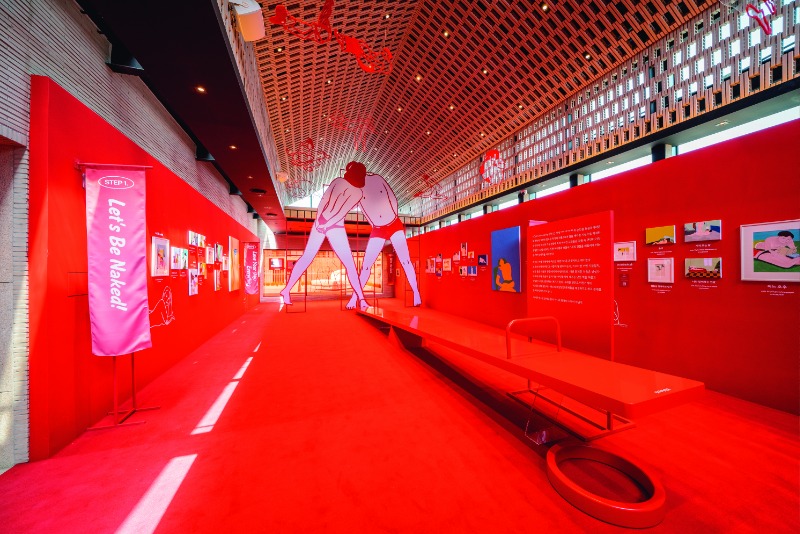
The “Red Room: Love is in the Air,” showing at GROUNDSEESAW Seochon. Examining love, dating and sex, the exhibition is rated 19 and over. The image shows the space where illustrator Minzo King’s work was displayed.
ⓒ MEDIA&ART
Contrary to live performances such as concerts, plays and musicals, art museums have remained relatively unscathed by the COVID-19 pandemic. In 2021, 19.3 percent of the Korean public visited an art museum or gallery, according to Statistics Korea, a decline of only 0.3 percent over the year before. But a pronounced change has occurred in the form of people’s visits. Those in their 40s and older typically viewed exhibitions online using their smartphones and computers, but the younger generation generally chose to go in person. Adults in their twenties and thirties – Korea’s so-called MZ generation, encompassing millennials and Generation Z – constantly seek out special experiences and pursue new interests. To them, art museums are destinations for taking photographs to share, shopping, and relaxing. In short, they are playgrounds. This contrasts sharply with their parents’ generation, for whom visiting an art gallery is a more decorous event.
Breaking the Mold
The groundwork for accommodating such changed attitudes began when Generation MZ had barely formed. The Daelim Contemporary Art Museum, near Gyeongbok Palace in central Seoul, has been at the forefront. In 2010, it hosted “Inside Paul Smith,” an exhibition of works of the British fashion designer that was hailed for bringing fashion into the museum. More significant, perhaps, was that the museum gave visitors permission to take photographs, starting the so-called “proof pics” trend. Before then, photography was strictly prohibited inside museums, but for young visitors, posing for photos in front of exhibits and quickly posting them on social media became a priority.
The Daelim Contemporary Art Museum, operated by the Daelim Cultural Foundation, recast its identity in 2012. Responding to the vague notion that art is difficult, it adopted the new slogan “Where the everyday becomes art.” Exhibitions that shed light on figures such as industrial designer Dieter Rams, fashion designer Karl Lagerfeld, and furniture designer Finn Juhl were more than enough to make the gallery’s presence known to the younger generation.
Among the museums operated by the Daelim Cultural Foundation, the D Museum in Hannam-dong, Seoul, is by far the most prominent on social media. Established in 2015 to mark the Foundation’s twentieth anniversary, D Museum presented the inaugural exhibition “Spatial Illumination – 9 Lights in 9 Rooms,” inviting the world’s most noted light artists to participate.
Capturing the imagination of visitors, the exhibition went viral on social media. At the time, the gallery revealed that as much as 68 percent of all visitors were in their twenties.
Innovative Curation
Recently, D Museum moved to a site near the Seoul Forest in Seongsu-dong. It is more accessible than its original location, being better connected to public transport links. The opening exhibit “Romantic Days,” running through the end of October this year, underscores the orientation of the museum. Visitors can appreciate the different moments and emotions of romance through works in several genres. The predominant feature of the story is its structure around seven famous scenes from popular Korean romance manhwa (comics and print cartoons).
Opened in 2012, the Seoul Museum in Buam-dong generally held solo exhibitions of contemporary artists or shows curated from its own collection. But in the manner of the Daelim Contemporary Art Museum, it has increasingly hosted exhibitions that cater to a youthful audience.
One example is the 2015 exhibition “The Temperature of Love.” It was slated for a three-month run but was so popular that it was extended for two months. With a total of 90,000 visitors over five months, the exhibition was lauded for its originality in grafting together popular music and artworks on the theme of love. Like hit films that spawn sequels, this exhibition was revived at the end of 2021 with a new structure and form.
The 2017 exhibition “Café Society” generated considerable interest thanks to the way the exhibition space resembled a café as a place for meeting and relaxation. Following these curatorial experiments, the Seoul Museum made a name for itself as a must-visit attraction. Located behind the gallery building is Seokpajeong, the summer residence of Yi Ha-eung (1821-1898), father of King Gojong (r. 1863-1907), the 26th ruler of the Joseon Dynasty. The fact that visitors to the gallery can also look around Seokpajeong and its graceful natural surroundings, not easily found in central Seoul, adds to the museum’s popularity.
Another innovative venue would be piknic in Hoehyeon-dong, downtown Seoul. Opened by curation agency Glint in 2018, it occupies a remodeled 1970s office building once used by a pharmaceutical company. Starting with “Ryuichi Sakamoto: LIFE, LIFE” to mark the fortieth anniversary of the Japanese composer and concert pianist’s debut; “Jasper Morrison: THINGNESS,” a retrospective of the British product and furniture designer; and an exhibition titled “Mindfulness,” the piknic menu has generated plenty of buzz. “GARDENING,” which ran from April to October 2021, proved particularly popular, as it explored the “pet plant” trend of using plants to relieve emotional pressure caused by the pandemic.
In addition, the ecological environment exhibition “TIMEWALKER the time travel corporation,” held last year at the Museum of Contemporary Art Busan, received outsized attention. Designed to raise awareness of the ecosystem destruction on Eulsuk Island in western Busan, once the largest migratory bird habitat in Korea, the exhibition adopted the form of an intermedia artwork. Splicing in the escape room format so popular with twenty-somethings, it required visitors to work together, using clues to decipher key codes in order to move to the next exhibition room.
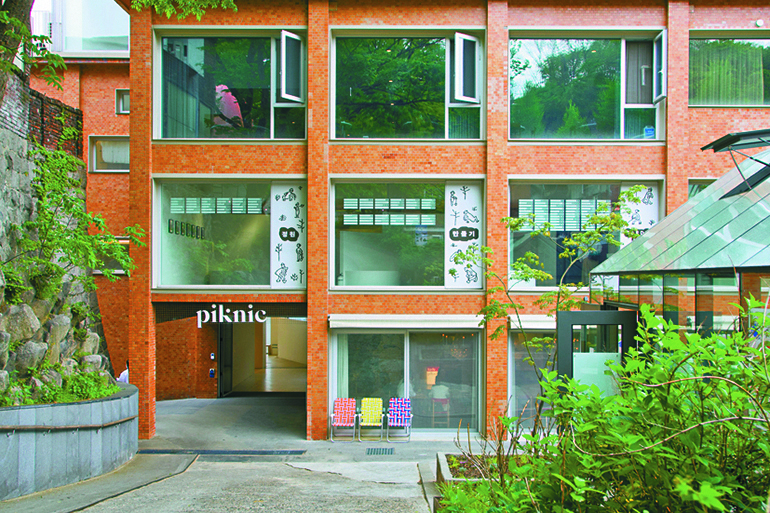
Housed in a building once used by a pharmaceutical company, the mixed culture space piknic in Hoehyeon-dong, downtown Seoul, is popular with the younger crowd. The rooftop is widely regarded as one of the best places for a photograph to post on social media.
ⓒ piknic
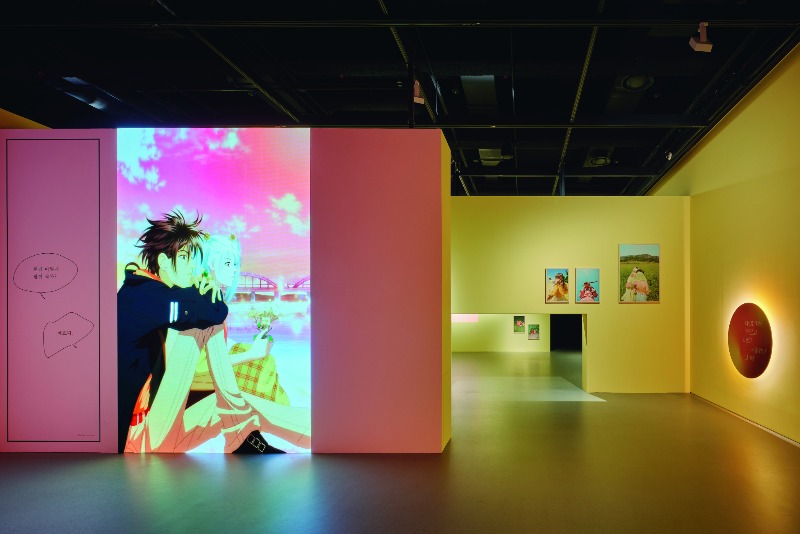
At D Museum, the reopened special exhibition “Romantic Days” reflected twentysomethings’ enjoyment of comics and webtoons and has been credited with making art galleries feel more accessible.
ⓒ D MUSEUM, Roh Kyung
Just Shopping
In November 2021, the National Museum of Korea opened the “Room of Quiet Contemplation,” featuring two pensive bodhisattvas that are national treasures of Korea. To celebrate the occasion, the National Museum Foundation of Korea sold miniature figurines of one of the statues. As people flocked to enter the contemplative space, these so-called “relic figures” quickly sold out.
Gift shops must not be left out when charting the changes occurring in the art museum scene. They are no longer an afterthought at the end of a visit. Just as the younger shoppers frequent curated shopping malls and boutiques, they are now flocking to museum gift shops. In the past, most people only went to the museum shop to buy exhibition catalogs, posters, and postcards.
These days, however, it is not unusual for visitors to skip an exhibition altogether and head straight to the gift shop.
When the Leeum Museum of Art reopened in October 2021, its gift store was stocked not with the usual books, catalogs and merchandise, but with stylish hand-crafted items made by artists to promote the concept of “starting my very first collection.” They included “Afterimage of Beginning” by artist Choi Byung-hoon and designer Lee Kwang-ho’s “Knot Series,” which were both released as limited edition miniature furniture. The high prices squeezed wallets but the response was overwhelming. The marketing was clearly attuned to the MZ generation’s consumption pattern: happy to open their wallets for something rare or unusual.
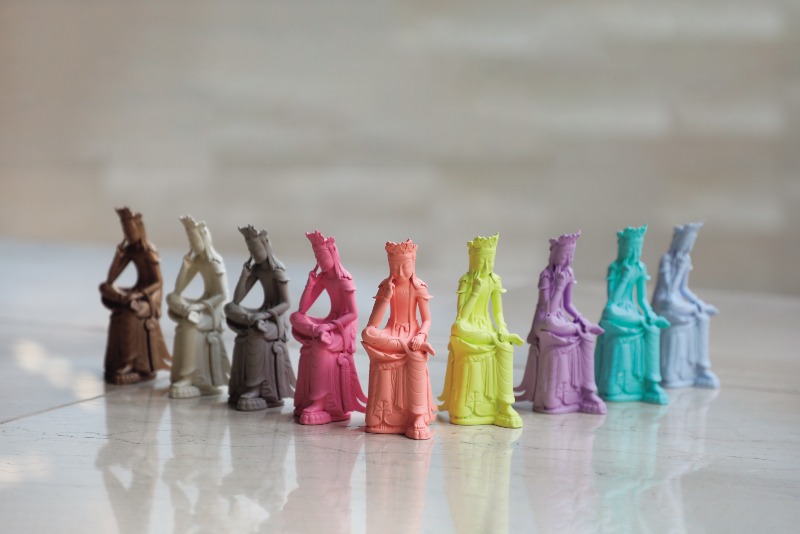
The National Museum Foundation of Korea offered a miniature version of a pensive bodhisattva sculpture, which completely sold out. The younger generation often visit museums just to buy merchandise, which is another new way of enjoying art.
ⓒ National Museum Foundation of Korea
>
New Collectors
Nowadays, the most famous influencer in the Korean art world is probably RM, the leader of BTS. He is an art lover who he has loaned pieces from his private collection to public museums. If an art gallery appears on his Instagram account, internet searches for that place increase instantly. It has reached such an extreme that people say galleries can be divided into places that RM has and has not visited. There is also now a so-called “RM gallery tour.” Despite concerns over the way such a small number of influencers have so much power, many believe that influencers introducing relatively less famous or newly opened spaces as well as up-and-coming artists can make a positive contribution to the art ecosystem.
Heightened interest in exhibitions and artists naturally progresses to the buying of artworks. Young visitors who have benefitted from the stock market, real estate, or cryptocurrency booms are jumping into the art market. They are also flocking in ever greater numbers to domestic art fairs. According to the 2021 “Kiaf SEOUL Report” by the Galleries Association of Korea, 53.5 percent of the visitors were first-time attendees. Among them, the MZ generation accounted for 60.4 percent. There is a growing interest in art among the younger crowd, not just for appreciating and enjoying artworks but also as investments, a huge leap from the days when taking selfies at a gallery was what mattered most.
The emergence of young collectors is under close attention. There are some who worry that treating artworks merely as objects for investment will disrupt the healthy development of the art market. But there are also many who feel that these younger collectors, who like to show off and communicate their personal tastes, will help expand the base of the market.
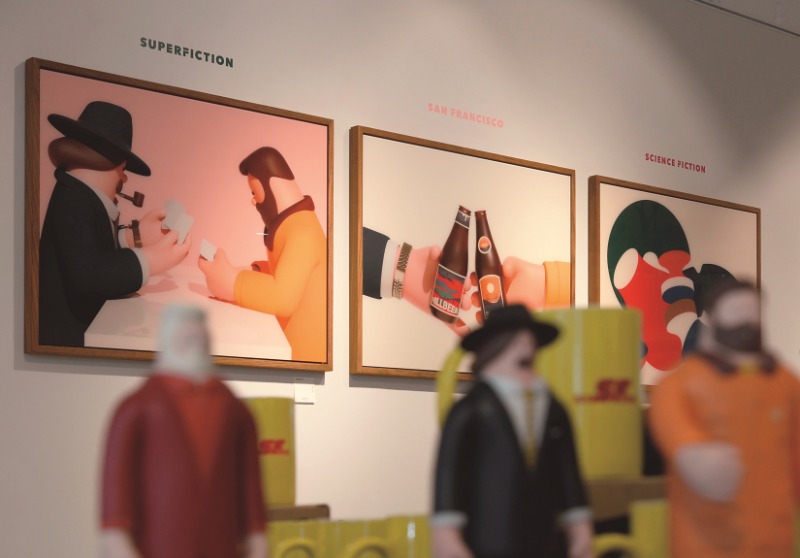
“SF. SF. SF,” Superfiction’s first solo exhibition, held in October 2016 at print bakery in Hannamdong, Seoul. Engaging in brand collaborations, Superfiction is a creative design studio, while print bakery is an art platform launched by Seoul Auction to popularize art.
Courtesy of Superfiction
Bae Woo-ri Reporter, Monthly Art